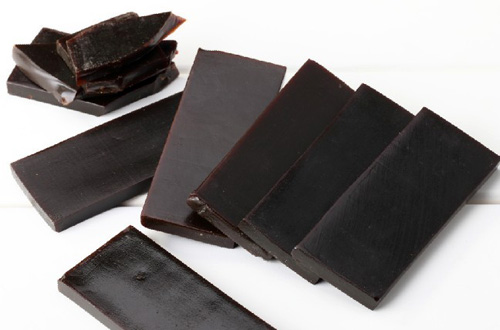The source is from donkey hide stewed and concentrated as gelatinous mass of Equus asinus L., family Equidae. The medicinal material is mainly produced in the areas of Shandong, Zhejiang, and Jiangsu, etc. The one produced in Dong'e County of Shandong Province is the most famous. It is used crudely, pounded into pieces or stir-baked with powder of clam, cattail pollen, and talc in- to pearl of Ejiao.
Medicinal Properties: Sweet in flavor, mild in nature and attributive to the lung, liver and kidney meridians.
Actions: Enrich the blood and stop bleeding, nourish yin and moisten dryness.

Application
1. For blood-deficiency with sallow complexion, dizziness and palpitation, it is usually combined with Shudihuang (Rhizoma Rehmanniae Praeparata), Danggui (Radix Angelicae Sinensis ), Huangqi ( Radix Astragali), and Dangshen (Haematitum), etc..
2. For various bleeding syndromes, especially for bleeding accompanied by insufficiency of yin and blood, it can be melted alone for oral use or combined with other medicinal herbs according to morbid conditions. For instance, in treating hematemesis and hemoptysis, it can be combined with Maimendong (Radix Ophiopogonis ) and Shengdihuang (Radix Rehmanniae) ; in treating hemafecia due to deficiency of spleen-yang and stomach-yang, usually combined with Baizhu (Rhizoma Atractylodis Macrocephalae ) and Fuzi ( Radix Aconiti Praeparata), such as Huangtu Tang (Decoction) ; in treating metrorrhagia and metrostaxis, excessive menstruation, bleeding during pregnancy and endless bleeding after miscarriage, usually combined with Shengdihuang (Radix Rehmanniae ) , Baishaoyao (Radix Paeoniae Alba ) and Aiye (Folium Artemisiae Argyi), such as Jiao Ai Tang (Decoction).
3. For vexation and insomnia due to yin-deficiency, usually combined with Huanglian ( Rhizoma Coptidis ), Baishaoyao (Radix Paeoniae Alba ), and Jizihuang (Vitellus Galli ), etc., such as Huanglian Ejiao Tang (Decoction).
4. For cough and dyspnea due to asthenia of viscera or dry cough due to yin-deficiency, it is usually combined with Shashen (Radix Adenophorae), Maimendong (Radix Ophiopogonis ), Sangye ( Folium Mori ), and Xingren ( Semen Armeniacae Amarum ) , etc.
Usage and Dosage:
It is melted and taken after mixing it with water, or dissolved in boiling water or millet wine; the dosage is 5 -10 g. For enriching blood and nourishing yin, the crude is used; for stopping bleeding, the one stir-baked with cattail pollen is suitable to be used; for moistening the lung, the one stir-baked with clam powder is suitable.
Notes:
It is rich in property and obstructs digestion, therefore, it is not suitable for deficiency of the spleen and stomach with poor appetite, abdominal distention and loose stool.







